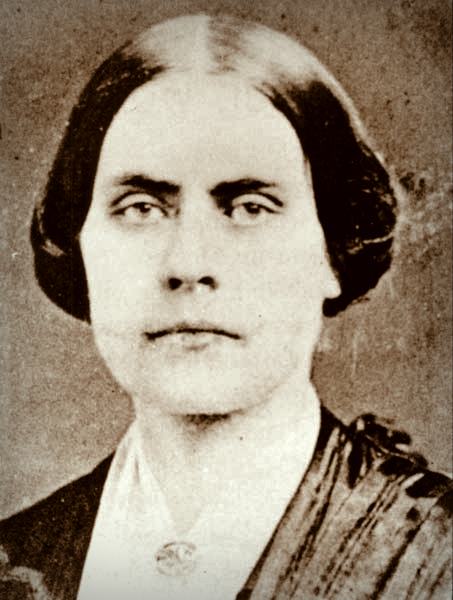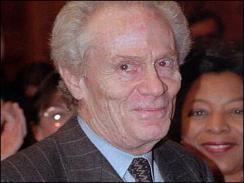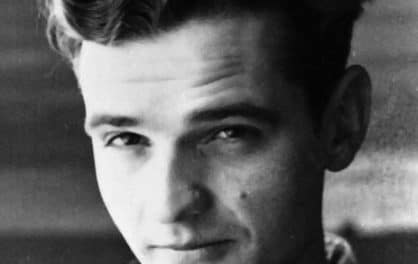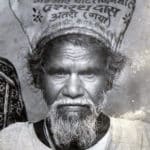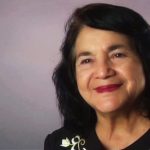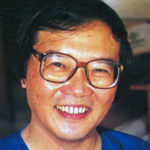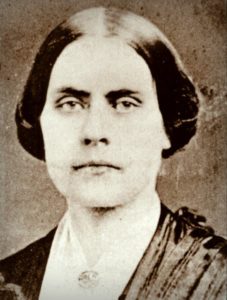
Feb. 15, 1820 – Mar. 13, 1906
“The Workhorse of the Women’s Rights movement”
Susan B. Anthony grew to become a courageous leader in educational reform, labor activism, abolitionism, temperance, and most prominently, women’s rights. Her courage began to build in small ways, from organizing meetings and passing out flyers, to eventually facing the United States of America in court to defend the rights of women. Despite strong resistance, Susan was relentless in her pursuit of justice, freedom and equality and her lifelong legacy is more than a memory of someone who dreamed big, but someone who took heroic actions as well.
Susan Brownell Anthony was raised in a Quaker family, led by her father Daniel who had devoted many years towards integrating abolitionist views with the Quaker views. Her mother Lucy, formerly a Baptist was active in the women’s rights movement long before meeting Daniel. The two decided to marry and raise their children to respect self-discipline, hold to their convictions, and believe in their equal self-worth.
History reveals that Susan’s parents did well. Two brothers became leaders of the Anti-slavery movement in Kansas, while one of her sisters became a teacher and woman’s rights activist. Susan herself was a brilliant child, learning to read and write at the age of three. When her father learned that her local school had refused to teach her long division because she was a female, he joined the local homeschool group to teach her himself. Other teachers also helped instill a strong view of womanhood and equality in the young Susan. By the age of 17, Susan was already active in organizing and collecting petitions for the anti-slavery movement.
Like many young women even today, Susan was insecure and self-conscious about her appearance. She also had anxiety for public speaking, was scared to raise her voice and never planned on being a leader. At last, she determined that the need for justice was more important than protecting her insecurities so she began to use her voice to influence others. Susan quickly became an eloquent orator, intelligent and powerfully persuasive. She was often invited to speak at conventions, rallies, and meetings. In later years she would end up traveling the United States giving up to 100 speeches each year.
“We do not stand up here to be seen, but to be heard.” – Susan B. Anthony
The recession in 1837 impacted her family hard and ended her formal education. Never one to give up, Susan began teaching to help pay off her father’s debts. By the age of 26 she had become headmistress at the Canajoharie Academy, but even then she was only paid 1/5 of what the male headmasters earned.
Eventually, Susan moved back to the family farm in Rochester, New York to collaborate more closely with anti-slavery activists and temperance movement leaders such as Frederick Douglass, William Lloyd Garrison, and Amelia Bloomer. There she became secretary for the Daughter of Temperance and began using her organizing skills to support the movement.
At the age of 31, Anthony was introduced to Elizabeth Cady Stanton, another up-and-coming activist. Stanton and Anthony shared a strong passion for women’s rights and social change. They became close friends and allies and would spend the better part of their lives collaborating together on various issues. When they were denied admission into a temperance society due to being women, Anthony and Stanton started their own (the Woman’s State Temperance Society of New York). When their society’s petitions and signatures were rejected by politicians because they were mostly from women, they realized women really needed the right to vote.
“We ask for our rights not as a gift of charity, but as an act of justice… as a woman has to pay taxes to maintain government, she has a right to participate” – Susan B. Anthony
The eloquent and feisty Susan B. Anthony began taking on various roles in many organizations. She became a principal organizer for the American Anti-Slavery Society in New York, the president of the National Women’s Rights Convention in 1858, a publisher and business manager for The Revolution weekly journal, president of the National American Woman Suffrage Association, co-founder of the American Equal Rights Association and a leader in many others.
Anthony and Stanton used The Revolution to write about labor issues, women’s rights, education needs, and as a space to denounce slavery, lynching and organized prejudice. Susan also used the journal as a means to practice what they preached, by hiring women laborers and paying them high wages.
The once-shy Susan had now become bold and courageous. For a year she cut her hair short and began wearing bloomers instead of dresses. She campaigned for women to be able to own their own property, keep their own wages and maintain custody of their children. She spoke for the need for women jurors, fair divorce laws, equal pay for equal work, the eight hour work day, protections of women by trade unions and the need for livable wages. She advocated for university access for former slaves and women and served on the board of trustees in Rochester in an effort to secure quality public education regardless of gender.
In one risky move, she was just shy of raising $50,000 dollars in pledges to help get women admitted to the University of Rochester. With the deadline approaching, she threw in her entire life insurance policy, forcing the university to follow through with its promises and admit women for the first time.
Susan’s very public efforts gained her both loyal friends and harsh enemies. Political cartoonists mocked Susan through caricatures and newspaper editorials, and her effigies were drug through towns and mockingly hung. Men frequently tried to block her efforts, and women were often too scared to stand in her defense. She was mostly ridiculed for being single and unmarried and for simply “not acting like a woman should.”
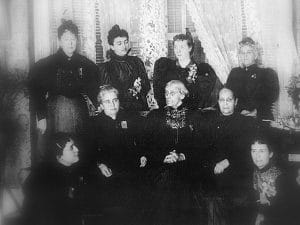
1896 California meeting of Suffragist leaders: standing (L to R) Ida H. Harper,
Selena Solomons, Carrie C. Catt, Anne Bidwell, (seated L to R) Lucy Anthony,
Dr. Anna H. Shaw, Susan B. Anthony, Ellen Clark Sargent, and Mary Hay.
Susan lived a life some would call reckless. She rarely had money, was often in and out of debt, pouring any extra funds she had back into the movement. She never married and instead invested all of her time and energy into securing equal rights for women. She used her keen mind to develop new methods of grassroots organizing (methods so successful they are still used today). Her commitment to peaceful action, respectful and intelligent debate gained the attention and help of many town leaders curious to hear what an odd outsider woman had to say.
“Some think this is harvest time for the black man, and seed-sowing for woman. Others, with whom I agree, think we have been sowing the seed of individual rights, the foundation idea of a republic for the last century, and that this is the harvest time for all citizens who pay taxes, obey the laws and are loyal to government.” – Susan B. Anthony
After the 14th Amendment had passed allowing former slaves to be citizens, Susan creatively interpreted the amendment to assume “all persons born or naturalized” must also include women. In 1872 she argued her case to the election inspectors and was allowed to register and vote. However, a few days later Susan was arrested charged with “illegal voting.” In the weeks leading up to her trial, Susan canvassed the county, giving her impressive speech in every city justifying why she voted.
The prosecution argued that she had actively swayed the population of jurors and had the trial moved to another county. Susan did the same in the next county, speaking for 21 days straight. In the end, the judge ruled “She is not competent as a witness in her own behalf” because she was a woman. He charged her as guilty and sentenced to a $100 fine. Susan replied, “May it please your honor, I will never pay a dollar of your unjust penalty.” She never did, and the government, perhaps knowing they were in the wrong, never pressed for collections.
At her trial the judge asked, “You voted as a woman, did you not?” Susan B. Anthony replied, “No, sir, I voted as a citizen of the United States.”
It would be another 47 years before women would be allowed to vote nationwide. Despite limited gains in her lifetime, Susan B. Anthony never gave up, she spent the rest of her life creatively supporting the movement, using her voice and her influence to inspire men and women towards the goal of equality. Her words and speeches helped educate the nation about the need for equal rights for women. 14 years after her death the Nineteenth Amendment to the U.S. Constitution was passed and women were allowed to vote nationwide. Many of her other goals became a reality shortly thereafter.
Susan B. Anthony rarely acted alone. She surrounded herself with a company of amazing leaders, activists, and intellectuals. Yet, her peers and those who followed were inspired because of her amazing courage and absolute dedication. Susan died at the age of 82 in 1906, having helped lead one the longest peaceful rights movement in history. She remained inspirational to the end, even using her dying words to call others to action, “Failure is impossible!”

